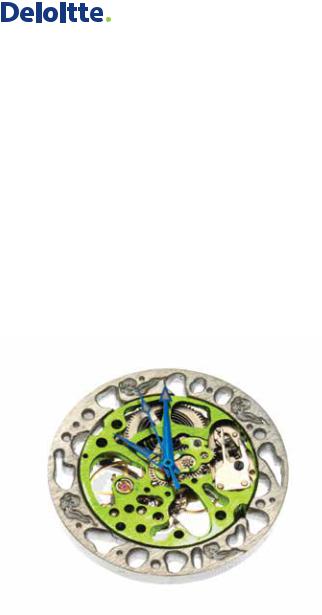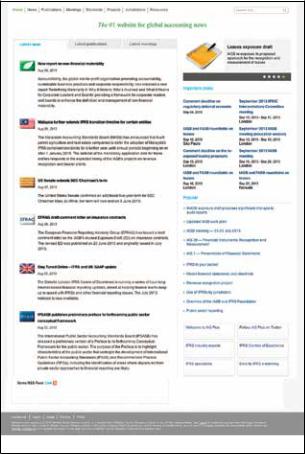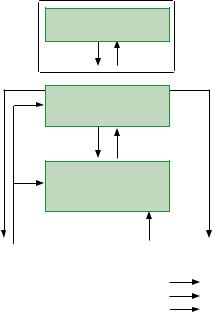
IFRS in your pocket 2013
.pdf
IFRS in your pocket 2013
Foreword
Welcome to the 2013 edition of IFRS in Your Pocket, which provides an update on developments up to the first quarter of 2013. We cover all of the material which has made this publication an annual world-wide favourite: background information on the structure and workings of the IASB; analysis of the use of IFRSs around the world; summaries of all current Standards and Interpretations; and up-to-date details of IASB and IFRIC agenda projects. It is the ideal guide, update and refresher for everyone either contemplating a move to IFRSs or already reporting under the IFRS framework.
Last year was one of change and a gradual strengthening of the standardsetting process even though progress on the most difficult projects proved complex and contentious. It was a year when the results of a variety of governance reviews and strategy reviews brought a strengthening of the process of the IASB. And it was a year of taking stock on progress. In the words of Michel Prada, the new Chairman of the IFRS Foundation Trustees, the IASB in its short history has gone from ‘an innovative international start-up’ to ‘an international standard-setter that issued words that would be written into law verbatim by the nations of the world’. Over half of the Fortune Global 500 Companies now report using IFRS. The establishment of an Accounting Standards Advisory Forum, (ASAF), by the IASB was intended to expand dialogue with the global standard-setting community, and this turned into one of the themes of the year. ‘Having spent the first decade working one-to-one with other standards setters’, said IASB Chairman Hans Hoogervorst, ‘we have now set a new, more inclusive and multi-lateral path’.
Efforts were concentrated on speeding up the progress on some of the key projects and publication of exposure drafts on revenue recognition, financial instruments, leases and insurance contracts. This once again brought into focus convergence efforts with the US standard-setter, the FASB. Referring to revenue recognition in particular Hoogervorst made the point that a ‘fully converged standard is, in my view, the jewel in the crown of the convergence programme’.
In terms of improvements more broadly to financial reporting, the IASB responded to what Hoogervorst referred to as ‘concerns that financial reports contain too much irrelevant and unconnected information’ by instituting a process of round-tables and other efforts to rationalise what was increasingly referred to simply as clutter. And a revitalised programme to bring a full conceptual framework into being also got under way.
The hope is that the combination of efforts to bring about an endgame for some of the most contentious topics which the IASB has ever faced, along with greater cooperation and understanding around the world, will bring greater gains for IFRS.
Veronica Poole
Global IFRS Leader
Foreword 1

Our IAS Plus website
Deloitte’s IAS Plus (www.iasplus.com) is one of the most comprehensive sources of global financial reporting news on the Web. It is a central repository for information about International Financial Reporting Standards (IFRSs) as well as the activities of the International Accounting Standards Board (IASB). The site, which is also available in German, will soon include portals tailored to the United Kingdom and the United States, each with a focus on local GA AP and jurisdiction-specific corporate reporting requirements. More portals are planned for the future.
2
IAS Plus features:
ōnews about global financial reporting developments, presented intuitively with related news, publications, events and more;
ōsummaries of all standards, interpretations and projects, with complete histories of developments and standard-setter discussions together with related news and publications;
ōrich jurisdiction-specific information, including background and financial reporting requirements, links to country-specific resources, related news and publications and a comprehensive history of the adoption of IFRSs around the world;
ōdetailed personalisation of the site, which is available by selecting particular topics of interest and viewing tailored views of the site;
ōdedicated resource pages for research and education, sustainability and integrated reporting, accounting developments in Europe, global financial crisis, XBRL and Islamic accounting;
ōimportant dates highlighted throughout the site for upcoming meetings, deadlines and more;
ōa library of IFRS-related publications available for download and subscription – including our popular IFRS in Focus newsletter and other publications;
ōmodel IFRS financial statements and checklists, with many versions available tailored to specific jurisdictions;
ōan extensive electronic library of both global and jurisdiction-specific IFRS resources;
ōexpert analysis and commentary from Deloitte subject matter experts, including webcasts, podcasts and interviews, and further analysis from respected financial journalist Robert Bruce;
ōe-learning modules for most International Accounting Standards (IASs) and IFRSs;
ōenhanced search functionality, allowing easy access to topics of interest by tags, categories or free text searches, with search results intuitively presented by category with further filtering options;
ōDeloitte comment letters to the IASB and numerous other bodies; and
ōfreedom to access the information through the Web, mobile, RSS, Twitter and more.
Our IAS Plus website 3
Contents
|
Page |
Abbreviations |
5 |
IASB structure |
6 |
Members of the IASB |
9 |
IASB due process |
11 |
IASB contact information |
13 |
Obtaining IASB pronouncements and publications |
14 |
IASB chronology |
15 |
Use of IFRSs around the world |
19 |
Recent pronouncements |
25 |
Summaries of current Standards and related Interpretations |
27 |
Current IASB agenda projects |
102 |
Interpretations |
106 |
IFRS Interpretation Committee current agenda issues |
108 |
Deloitte IFRS resources |
109 |
Deloitte IFRS e-learning |
110 |
Website addresses |
111 |
Subscribe to our IFRS publications |
112 |
Contacts |
113 |
4
Abbreviations
DI |
Draft interpretation |
DP |
Discussion paper |
EC |
European Commission |
ED |
Exposure draft |
EEA |
European Economic Area (EU 28 + 3 countries) |
EFRAG |
European Financial Reporting Advisory Group |
ESMA |
European Securities and Markets Authority |
EU |
European Union (28 countries) |
FASB |
Financial Accounting Standards Board (US) |
FEE |
Federation of European Accountants |
GAAP |
Generally Accepted Accounting Principle(s) |
IAS(s) |
International Accounting Standard(s) |
IASB |
International Accounting Standards Board |
IASC |
International Accounting Standards Committee (predecessor |
|
to the IASB) |
IASCF |
IFRS Foundation (predecessor to the IFRSF) |
IFRIC |
IFRS Interpretations Committee (previously “International |
|
Financial Reporting Interpretations Committee of the IASB, |
|
and Interpretations issued by that committee” – see below) |
IFRS(s) |
International Financial Reporting Standard(s) |
IFRSF |
IFRS Foundation, parent body of the IASB |
IOSCO |
International Organization of Securities Commissions |
NCI |
Non-controlling interest(s) (previously “minority” interests) |
RFI |
Request for information |
SAC |
IFRS Advisory Council (previously “Standards Advisory |
|
Council” – see below) – advisory to the IASB |
SEC |
Securities and Exchange Commission (US) |
SIC |
Standing Interpretations Committee of the IASC, and |
|
Interpretations issued by that committee |
SME(s) |
Small and medium-sized entity(ies) |
Abbreviations 5

IASB structure
Monitoring Board
Approve and oversee trustees
IFRS Foundation
Appoint, oversee, review effectiveness and funding
Board
Set technical agenda, Approve
Standards, Exposure Drafts and
Interpretations
IFRS Advisory Council |
|
IFRS Interpretations Committee |
|
|
|
Appoints
Reports to
Advises
Monitoring Board
The primary purpose of the Monitoring Board provides a mechanism for formal interaction between capital markets authorities responsible for the form and content of financial reporting and the IFRS Foundation (IFRSF). In particular, it assures public accountability of the IFRSF through a formal
reporting line from the IFRSF through a formal reporting line from the IFRSF Trustees to the Monitoring Board.
6
The responsibilities of the Monitoring Board include:
ōparticipating in the process for appointing trustees and approving the appointment of trustees according to the guidelines set out in the IFRSF’s Constitution;
ōto review the adequacy and appropriateness of Trustee arrangements for financing the IASB;
ōreview the Trustees’ oversight of the IASB’s standard-setting process. In particular, with respect to its due process arrangements;
ōto confer with the Trustees regarding the responsibilities, particularly in relation to the regulatory, legal and policy developments that are pertinent to the IFRS Foundation’s oversight to the IASB; and
ōreferring matters of broad public interest related to financial reporting to the IASB through the IFRS Foundation.
As at 30 June 2013, the Monitoring Board comprised the relevant Member of the European Commission, and the chairs of the Financial Services Agency of Japan, the US Securities and Exchange Commission (SEC), the Emerging Markets Committee of the International Organisation of Securities
Commissions (IOSCO) and the Chair of the IOSCO Board. The Basel Committee on Banking Supervision is a non-voting observer.
In May 2013, the Monitoring Board commenced a process to appoint up to a further four members. Prospective members must be a capital markets
authority responsible for setting the form and content for financial reporting in its jurisdiction and meet certain requirements about the use of IFRSs in that jurisdiction and continuing participation in the IFRS Foundation’s funding arrangements.
IFRS Foundation
Composition: 22 individual trustees, one appointed as Chair and up to two as Vice-Chairs. Trustees are appointed for a three-year term, renewable once. Regardless of prior service, a trustee may be appointed to serve as Chair or Vice-Chair for a term of three years, renewable once, provided total years’ service as a trustee does not exceed nine years.
Geographical balance: six trustees from the Asia/Oceania region; six from Europe; six from North America; one from Africa; one from South America and two from any area (subject to maintaining overall geographical balance).
Backgrounds of trustees: the IFRSF Constitution requires an appropriate balance of professional backgrounds, including auditors, preparers, users, academics, and other officials serving the public interest. Two will normally be senior partners of prominent international accounting firms.
IASB structure 7
International Accounting Standards Board
Composition: 16 Board Members, of whom one is appointed as chair and up to two as vice-chairs. Up to three members may be ‘part-time’ members. IASB members are appointed for an initial term of five years, renewable for a further three years. The chair and vice-chairs may serve second terms of five years, subject to an overall maximum term of ten years.
Geographical balance: to ensure a broad international diversity, there will normally be four members from the Asia/Oceania region; four from Europe; four from North America; one each from Africa and South America; and two appointed from any area, subject to maintaining overall geographical balance.
Backgrounds of Board members: the main qualification for membership is professional competence and practical experience. The group is required to represent the best available combination of technical expertise and diversity of international business and market experience.
8
